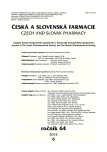Determination of antigripal drugs (pheniramine, phenylephrine) in biological samples by on-line CITP-CZE coupled with tandem mass spectrometry
Authors:
Juraj Piešťanský; Katarína Maráková; Peter Mikuš
Authors‘ workplace:
Department of Pharmaceutical Analysis and Nuclear Pharmacy, Faculty of Pharmacy, Comenius University, Bratislava, Slovak Republic
Published in:
Čes. slov. Farm., 2015; 64, 273-274
Category:
44<sup>th</sup> Conference drug synthesis and analysis
Introduction
Paracetamol, pheniramine, and phenylephrine are typical drugs presented in over-the-counter (OTC) medicines against cough, cold and influenza. These three drugs with different pharmacotherapeutic activities can be described as antigripal drugs. Paracetamol (PCM) is an analgesic and antipyretic, pheniramine (PHM) is a H1-antihistamine, and phenylephrine (PHE) is a α1-adrenergic receptor agonist which is used as a nasal decongestant. Theraflu® is a typical commercial OTC medicine with the presence of these drugs.
Experimental methods
A modular capillary electrophoresis analyzer EA-102 (Villa Labeco, Spišská Nová Ves, Slovakia), assembled in the column-coupling configuration (hydrodynamically closed) of the separation unit, was used in this work for performing the CITP-CZE runs (cationic regime of the separation). The samples were injected by a 10 μL Hamilton syringe via a rubber septum into the injection block of the analyzer. An CITP column was provided with an 800 μm I.D. polytetrafluorethylene (PTFE) capillary tube of a 90 mm length and a contactless conductivity detector. A CZE column was the same as the CITP one except for a 300 μm I.D. and a 160 mm length. The CZE column was provided with an on-column conductivity detector (Villa Labeco). Win ACES software, ver. 1.4 (Faculty of Natural Sciences, Comenius University, Bratislava, Slovakia) was used for controlling the analytical protocol. The experiments were performed in the constant current mode at 20 °C. The driving currents applied were 300 μA (ITP) and 40 μA (CZE).
Identification and quantification of the analytes were performed on a triple quadrupole mass spectrometer (QqQ) Agilent 6410 Series Triple Quadrupole (Agilent Technologies, Santa Clara, CA, USA) coupled to the CE analyzer through an ESI interface and an elution block (coupling CE with ESI) proposed by Foret et al.1). The mass spectrometer operated in the positive-ion mode. The MS detection was carried out in the multiple reaction monitoring (MRM) mode.
Results and discussion
The CITP-CZE-ESI-QqQ system was optimized in order to obtain sufficient sample clean-up and good performance parameters so the method could be used in a direct analysis of antigripal drugs in human urine. The optimum CITP-CZE conditions were:
- CITP – LE = 10 mM NH4Ac + 20 mM HAc (pH = 4.5), TE = 10 mM HAc (pH = 3.1), driving current 300 μA;
- CZE – BGE = 10 mM HAc (pH = 3.1), driving current 40 μA.
PCM did not migrate properly in the CE system without electroosmotic flow (EOF) and it could not be detected in hydrodynamically closed CE separation system under given CITP conditions. Therefore, PCM was not considered further in this study. The optimum composition of the spray liquid was methanol/water (50/50, v/v) with 0.1% (v/v) HAc and its flow rate was 2 μL.min–1. For the ESI-QQQ mass spectrometer, the optimum parameters were as follows:
- nebulizer pressure (15 psi);
- drying gas temperature (300 °C);
- drying gas flow rate (5 L ⋅ min–1);
- capillary voltage (5000 V);
- fragmentor voltage (100 V) and
- collision energy (10 eV – PHM, 8 eV – PHE).
Mass spectrometry measurements were carried in MRM mode with the following transitions for pheniramine: m/z 241.2 → 196.1 (quantifier) and 241.2 → 168.1 (identifier) and for phenylephrine: m/z 168.1 → 150.3 (quantifier) and 168.1 → 135.1 (identifier).
For validation of the proposed method, a model human matrix spiked with PHM and PHE standards was used. Calculated performance parameters confirmed good linearity (r2 > 0.999), accuracy (R > 98.0%) and precision (RSDtm < 1.50% and RSDarea < 8.00%) of the proposed method. Finally, the CITP-CZE-MS/MS method was applied to monitor the level of excreted PHM and PHE in human urine after oral administration of one dose of Theraflu® (20 mg pheniramine maleate, 10 mg phenylephrine hydrochloride per one dose – sachet) to the volunteers. Samples were collected in various time intervals (0–24 h). The concentration profiles of excreted pheniramine and phenylephrine in human urine were successfully obtained by means of the studied method. Pheniramine metabolite, monodesmethyl-pheniramine, was also identified in the real urine samples (identifier – m/z 227.2 → 118.2 and quantifier – m/z 227.2 → 196.1).
Conclusions
The presented CITP-CZE-ESI-MS/MS combination represents a powerful tool for the analysis of relative unpretreated (only diluted) biological samples containing different trace and/or ultratrace concentration levels of cationic drugs and their metabolic products.
This work was supported by the projects VEGA 1/0873/15, KEGA 022UK-4/2015 and by the grant from the Faculty of Pharmacy Comenius University (FP CU), namely FaF UK/3/2015 and carried out in the Toxicological and Antidoping Center (TAC) FP CU.
Conflicts of interest: none.
PharmDr. Juraj Piešťanský, PhD.
Department of Pharmaceutical Analysis and Nuclear Pharmacy, Faculty of Pharmacy, Comenius University
Odbojárov 10, 832 32, Bratislava, Slovak Republic
e-mail: piestansky@fpharm.uniba.sk
Sources
1. Tomáš R., Kovaľ M., Foret F. Coupling hydrodynamically closed large bore capillary isotachophoresis with electrospray mass spectrometry. J. Chromatogr. A 2010; 1217, 4144–4149.
Labels
Pharmacy Clinical pharmacologyArticle was published in
Czech and Slovak Pharmacy

2015 Issue 6
Most read in this issue
- Antibacterial activity of natural compounds – essential oils
- Body surface area and body weight of Czech adult cancer population
- Cholinergic system of the heart
- From an old drug to a new one: Synthesis of valproate from 5,5-dipropylbarbituric acid
